
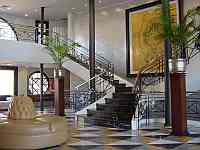
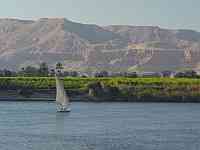
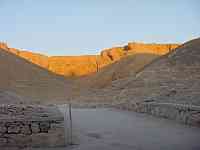
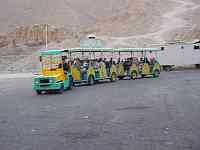
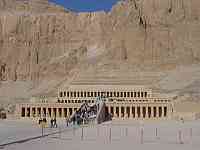
| Go to Allan's Page | Back to Egypt part 1 | Our HOME page | Holidays Home Page | Go to Deb's Page |
| FlickR album of these photos |
Continued from Part 1 (Cairo and Lake Nasser).
After a short flight we reached Luxor and went to the museum - well worth a visit - before joining our second ship the "Sun-Ray". This is one of the newest ships on the Nile, and to our amazement it was even more luxurious than the "Nubian Sea". Once again the food and the service were magnificent, and the ship (20m long, 14m beam, and flat-bottomed) was treated just like a canal boat - the captain even made us feel at home by running aground twice and by losing a fender (and the hand-rail it was tied to) while passing through an old lock-chamber.
The schedule on this part of the Nile was much more hectic than on Lake Nasser. Our visit to the Valley of the Kings (where the hordes of people made it feel more like a theme-park attraction) was extremely rushed despite a pre-dawn start. We had time to visit only three Kings' tombs, and there was not enough time to see Tutankhamen's tomb as well. Then we had half an hour at the temple of Queen Hatshepsut before we were allowed just a few minutes at the Valley of the Queens on our rapid coach-ride back to the ship. We spent the afternoon relaxing with a few beers beside the ship's pool as we sailed southwards past fields of sugar cane being harvested by men, women, and children with the aid of hand tools, donkeys and bullocks, tractors and vans, motor and sailing boats.
 |
 |
 |
 |
 |
 |
M/S "Sun Ray" |
The lobby and reception area of the ship |
Across the Nile to the West bank from Luxor |
Sunrise over the Valley of the Kings |
One of the Tourist trains at the Valley of the Kings |
The temple of Queen Hatshepsut |
Our next stop was at Esna where there was a single lock to negotiate. There were boats everywhere moored, anchored, or just drifting, as we joined the end of the 15-hour queue (about 30 boats were waiting, 2 boats just fit in the lock end-to-end, and it took an hour to fill and then empty the lock). This was a golden opportunity for the locals to try and sell us their wares of cotton robes, heaEgyptarves, carpets, etc. Before the ship had even stopped an armada of rowing boats had joined us, and a rain of plastic bags full of clothing fell upon the deck; the idea is that you either throw them back, or take one and begin haggling over the price. All great fun, but the prices were not as cheap as in the ship's on-board shop. It was essential to buy something, for on a couple of nights the ship would only serve you dinner if you were wearing Egyptian dress.
Soon after dawn it was our turn to pass through the lock, but the wait was not yet over because just beyond the new lock was the old "English Lock" which was only just big enough to take one boat. Although now no longer in use as a lock, it still had a swing bridge across the chamber which was only swung for a few minutes every four hours. While waiting for this we had ample opportunity to observe the village of Esna from the ship. The photo below shows a typical house, which is noticeably unfinished; as there is no need to protect against English-style weather, most houses are left unfinished and with no roof other than a sheet of canvas or some woven reeds, so that it is easy to add another storey if the children don't want to leave home. With their lack of glass windows (un-needed) and peeling paintwork, most houses look like wrecks although inside they may be quite luxurious with fine carpets and wall-hangings, air-conditioning and satellite TV. We had a small competition on board to photo the most tumble-down house with a satellite dish!
There are lots more pictures of the Valley of the Kings and the journey from Luxor to Esna.
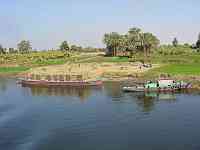 |
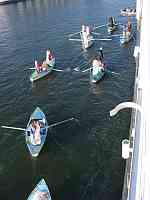 |
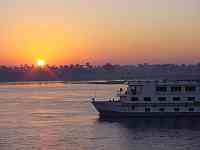 |
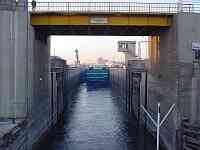 |
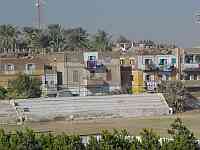 |
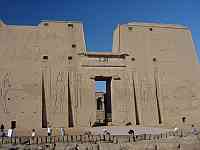 |
Harvesting the sugar cane |
Floating salesmen at Esna |
Esna in the early morning |
Following another ship into Esna Lock |
houses in Esna |
Edfu Temple |
By the time we left Esna we were at least half a day behind schedule, leaving only just enough time to visit the temple of Edfu in the afternoon before continuing to Kom Ombo for an unscheduled overnight stop. Kom Ombo has a fine temple, and is also the site of an new village to which most Nubians were relocated when the Aswan Dam was built.
After a short visit to the temple the next morning, we continued south and reached Aswan by lunchtime. Here we discovered the secret of obelisk-making and visited the High Dam.
There are lots more pictures of the journey from Esna to Aswan including the shipboard life, and of Aswan and the High Dam.
In the afternoon we took a boat to the temple of Isis at Philae, which was submerged by the building of the dam then dismantled and rebuilt on a nearby island; in the evening we returned to see the spectacular sound and light show there. The photo below shows the launch full of armed "Tourist Police". Since 1997 all tourists on excursions or travelling between cities are accompanied by police, who seem to be absolutely everywhere at the major attractions; the heightened security actually makes you feel relatively safe (locals that we spoke to had great sympathy for us living in such a lawless country as England - they had difficulty understanding what it must be like to need locks on the doors of your house and car). The police launch broke down just after this photo was taken.
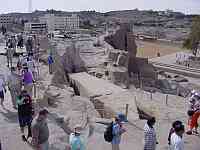 |
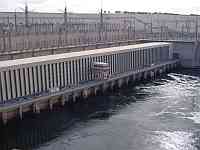 |
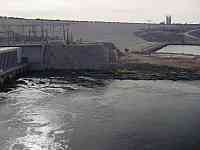 |
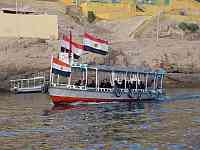 |
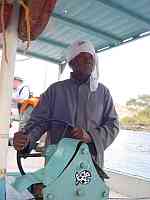 |
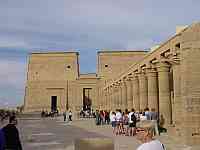 |
The unfinished obelisk at the Aswan quarry |
The the Aswan Dam power station |
The face of the Aswan Dam |
"Tourist Police" going to Philae temple |
Handsome Nubian steerer on the launch at Philae |
Philae Temple |
Philae temple carries graffiti from Napoleon's general, detailing his march to Aswan from Alexandria; it's carvings have been defaced by the early Christians in Roman times (literally - they chiselled the faces off the carvings because they were Graven Images of false gods) and replaced by carved Christian crosses. These are valuable antiquities in their own right - but at what point does graffiti cease to be acceptable? Is the scrawled signature of de Lesseps (the Frenchman who built the Suez canal and started the Panama canal) on a Greco-Roman Egyptian temple wall, a hideous defacement or a valuable piece of history? You decide!
Next morning, while other members of the ship took an early-morning flight to Abu Simbel, we took a boat trip upstream to a Nubian village. We were accompanied by numerous small children paddling crude (often home-made) boats offering to sing to us in any language in exchange for a small tip. Judging by the rolls of banknotes they were attempting to hide in their pockets, begging in this way can be quite lucrative. Upon realising that we were English, these children burst into a chorus of the traditional song "She'll be smoking marijuana when she comes" which certainly raised a laugh (and earned them a few pounds)!
 |
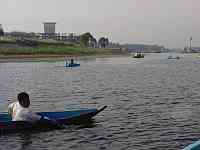 |
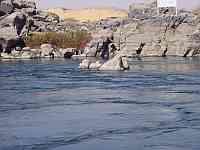 |
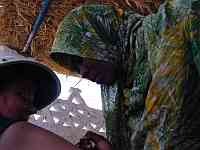 |
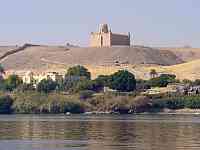 |
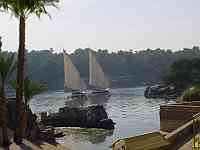 |
A Christian cross supersedes an Egyptian carving |
Small boy singer |
On treacherous waters near the cataracts |
Getting a henna tattoo |
The Aga Khan's mausoleum |
Feluccas (traditional Nile sailing boats) |
A visit to the beautiful gardens on Kitchener's Island provided a welcome break before we were taken upstream through the highly treacherous waters of the First Cataract, to the Nubian village. We were made very welcome as we visited a typical Nubian dwelling, drinking their mint or hibiscus tea, buying their home-made jewellery, and having henna tattoos (and giving them money). Returning downstream past the Aga Khan's mausoleum we had time for an afternoon sail in a felucca before starting back downstream towards Luxor. If you would like to see more, there is a whole page of pictures of Aswan, Philae, and the Nubian Vilage.
As we were still behind schedule the captain decided to travel all night to be at the head of the queue for Esna locks. Unfortunately the river level was very low, and in the darkness we ran aground on a sandbank near Kom Ombo for nearly two hours. Eventually the captain managed to pivot on the bows (which by then were well up the river bank) to force the stern upstream before reversing back into the deep water.
Despite the delay we still managed to reach Esna lock ahead of most other boats who had spent the night at either Kom Ombo or Edfu, but fate still had a trick in store for us. At the last moment the gates jammed half-way open, and in the ensuing emergency stop the ship bounced hard off a couple of jetties before coming to rest with the bows firmly jammed on a very rocky shore from which we had to winch ourselves free.
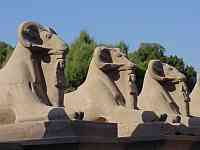 |
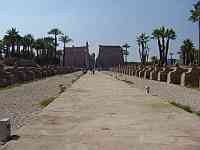 |
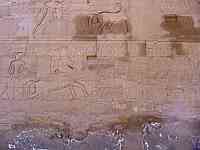 |
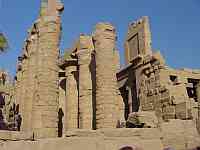 |
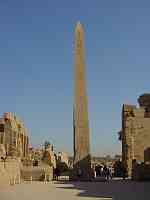 |
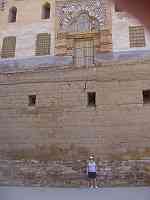 |
Sphinxes at the temple of Karnak |
The avenue of Sphinxes from Karnak to Luxor |
Slaves being brought back across the first Suez canal |
The hall at Karnak |
One of the original 6 Karnak obelisks. |
Entrance to a mosque built while Luxor temple was buried in sand |
Arriving back in Luxor we were joined by a dance troupe and a belly dancer, for the evening's entertainment, then spent the following morning seeing Karnak and Luxor temples. Each of these magnificent sites needs at least a whole day's visit, so we wished we'd booked to see some extra time in Luxor. The two temples are about 3km apart, and were once joined by a magnificent avenue of sphinxes. Karnak is simply enormous, having a main hall 100m x 50m with 134 columns that used to support the roof at a height of 25m. There is only one of the original 6 great obelisks standing; one of the others was taken away to London as a souvenir and sands by the Thames as Cleopatra's Needle.
Luxor temple has many Greek and Roman additions; the Romans simply broke down some of the walls and re-assembled them to make additional chapels, with no regard to the segments of carvings which are placed at random and are all ways up; this was unimportant to them because they plastered and painted the walls - we saw the fragment of a Roman-era mural of "The Last Supper" and wondered could a returning tourist have described it to Leonardo?
The whole area was buried under many feet of sand - as evidenced by the height in the air of the doorways of later buildings. Please take a look at the pictures of Karnak and Luxor.
Then in the afternoon we took a coach north to Dendera, a temple which is almost identical to that of Edfu; we had been going to go there by ship, but the river was just too low. Still, the coach trip was very interesting, and we enjoyed our final afternoon in Egypt before our early-morning flight back to a cold and damp Heathrow.
All pictures on this site are © Allan Jones unless otherwise stated